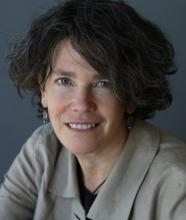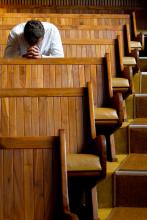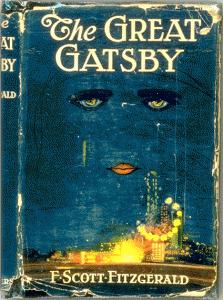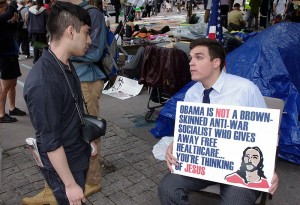Book
OURS IS AN age of interaction, mobility, and change. Unlike most of our grandparents, many of us have moved several times in our lifetimes and have seen our neighbors move in and out. We are more intensely aware, even in our own neighborhoods, that our kind of faith is not the only kind. We see how others have been shaped by very different histories than our own. It becomes clear to us that we, too, have been shaped—and continue to be shaped—by our own history.
Fuller Theological Seminary, where I teach, is in California. Every now and then we feel the ground shifting. The chandelier in our dining room swings or the bed on which we are lying begins to rock. The whole world may not be experiencing little earthquakes as we are, but people are surely experiencing change and variety in faiths and ideologies. This change and diversity can rock a person’s faith. We ask, How do we validate the truth of what we perceive and what we believe? In our time of pluralistic encounter with multiple ideologies and religions and with rapid social, economic, and political change, people search for what Dietrich Bonhoeffer called solid ground to stand on.
Philip Clayton teaches at Claremont Theological Seminary in California. He attended the mainline Presbyterian church that had been his church home since elementary school, plus an evangelical Bible study group, a charismatic prayer meeting once a week in a Pentecostal church, the Assemblies of God church, and a community of “Jesus People.” He writes:
Most of us know friends, colleagues, or acquaintances who are Christian, Jewish, Muslim; Buddhist, Hindu, Taoist; atheist, agnostic, “doubting believers”; pantheist, panentheist, neo-pagan; Mormon, Jehovah’s Witness, Church of God; Baha’i, Zoroastrian, perennialist—the list goes on and on. Faced with such a confusing array of options, more and more Americans are choosing not to choose ... You have to admit, pretty much everything these days is up for grabs. We are in the midst of the most rapid social and technological change that our species has ever undergone.

STANFORD UNIVERSITY anthropologist T.M. Luhrmann has managed to do what few other social scientists in academia dare do: explore how evangelical Christians relate with God.
In her latest book, When God Talks Back: Understanding the American Evangelical Relationship with God (Knopf), Luhrmann analyzes how evangelicals come to personally know God through prayer, communal support, and even “dates” with God. As part of her field research, she spent 10 years attending worship services, small groups, and events at Vineyard churches in Chicago and California. Known for their trendy, seeker-friendly, tear-inducing services and intimate Bible studies, the Vineyard is home to millions of evangelicals in the U.S. and around the world.
Without pitting reason (too much) against faith, Luhrmann applies psychological and anthropological understanding to evangelical Christian belief. Not bad for an outsider looking in. Sojourners assistant editor Elaina Ramsey spoke with Luhrmann in June.
Elaina Ramsey: What motivated you to study how evangelicals experience God?
T.M. Luhrmann: I’ve always been curious about how God became real for people. I knew that good, kind, wise people had different understandings of what was real, and that always fascinated me. While I was doing another research project, I was talking to this beach girl who told me that if I wanted to understand the God of her church, I should have a cup of coffee with him. I thought that was amazing. I decided then that I was going to figure out how people were able to experience God so vividly, so intimately, so dialogically.
PASTOR T.C. RYAN spent 40 years haunted by the shadow life of compulsive sexual behavior. Despite the challenges, Ryan never gave up hope of trying to reach the fullest recovery. He tells his story in Ashamed No More.
Compulsive sexual behavior put Tiger Woods into the headlines and made him an object of ridicule, as it has for so many others. In telling his own story, Ryan tears back the curtain to reveal the fuller story of painful realities, challenges, and hopes for those faced with the daunting task of recovery from similar compulsions.
“Those who are not addicted to sex understandably assume that the addict at least experiences enjoyment from the sexual activity, but this is not the case,” Ryan writes.
As Ryan describes it, he was living a divided life. In one arena he was a capable and gifted pastor. In the other he was plagued by shame, self-loathing, and an inability to stop destructive behavior. His extensive explanation of the cycle of addiction, the lies he had come to believe from childhood, the role that therapy and other supportive measures played in his recovery, and his hopes for how the church can become the ultimate 12-step program make every chapter of this book essential.

AS AN AUTHOR whose book sales have, shall we say, peaked, I took particular interest in the rising popularity of Just Love: A Framework for Christian Sexual Ethics, by Catholic Sister Margaret Farley. Until recently, her book had enjoyed only modest success, the predictable result of a title that gets the public’s blood racing with “sexual,” then quickly disappoints with the word “ethics,” the marketing equivalent of taking a cold shower while wrapped in a wet blanket. Toss in the word “Christian” and your sales possibilities are further reduced to a half dozen seminary students still looking for a thesis topic.
All of which violates the advice my grandmother gave me years ago: “Put sex in a book title, honey, and it’s money in the bank.” At least I think it was my grandmother.
But then a miracle happened. When officials at the Vatican read the book—between pensive walks in long robes (that’s what they do in the movies)—they were shocked and stunned, and immediately (six years later) declared it scandalous. This caused sales of Just Love to skyrocket. (Which proves the other thing my grandmother said: “No wait. I got it wrong. Have the Vatican criticize your book and then it’s money in the bank.”)
Vatican officials objected to Sister Farley’s frank theological exploration of modern sexuality which, anyone could have told her, is just not done when affiliated with a powerful religious institution that thinks “modern” means “the most recent part of the Middle Ages.” And back then, people didn’t talk about gay marriage or masturbation or any of the other issues Sister Farley thoughtfully ponders, not without enjoying the church’s hospitality sitting in wooden stocks for a few days.
AFRICAN-AMERICAN women’s wisdom emerges from an experience of triple (or more) oppression. Denied the dignity of womanhood, condemned for their skin color, whether too dark or too light, and often imprisoned by mis-education, demeaning and meaningless work, and a denial of their very humanity, African-American women have yet managed to forge a spirituality of hope and survival that has sustained them for centuries.
As Alice Walker noted, they dreamed dreams and had visions; they imagined a time and place when the pain and indignity of their lives would be transcended, not in some far-off heaven but right here in the future of their children and their children’s children. Somehow our foremothers persisted in their faith. They made rosaries out of beads and knotted string and learned scripture by rote memory. They resisted as best they could anything and anyone who attempted to keep them from living their faith on a daily basis.
Once freedom, so-called, came, they struggled, despite the callous disregard of their fellow Christians, to remain faithful. When their children were forbidden entry into diocesan or public schools, when they were required to sit in upper galleries and back pews, when they had to wait until last to partake of the sacraments, they did not suffer these indignities quietly but often walked out and with their meager resources built their own schools and church buildings.
JOIN ME IN your imagination for a few minutes in the high Andes. The bamboo that arches over us here—like the tree that arches over your yard or nearby park—is at this very moment taking the carbon you and other creatures are breathing out. It then reforms this carbon into carbohydrate, powered by solar energy and hydrated with water (photosynthesis). It is making sugar from that CO2. The plant then uses this sugar to provide the energy and materials for making all sorts of new substances.
For example, if I take a leaf from a plant (such as lettuce or kale) and chew and swallow it, it is transformed within me to produce materials for sustaining my life, powering my walking and speaking and writing. And from its use I release carbon dioxide, returning through this gas the very same carbon the leaf had absorbed through the stomatal pores on its surface and incorporated into the leafy food I ingested. To complete the remarkable carbon cycle, the carbon I breathe out is eventually taken up again by green plants that in turn produce food for humans, bugs, birds, and batrachians! (Let’s hear a doxology!) Without green plants, all human life perishes—and most other animate life as well.
Plants accomplish a myriad of activities out of our sight. Beneath lawns and gardens, forests and prairies, roots are moving water from the soil, pulling it up through stems into the leaves and back into the atmosphere. All forests, all trees, all vegetation—great movers of water—are constantly returning to the atmosphere water that had fallen as rain. It rises again and again within the thin fabric of the biospheric envelope and condenses into those white clouds you see above to fall down again to water the earth.
WRITER Cheryl Strayed’s unusually apt last name was self-selected in the wake of her mother’s premature death from cancer and after her first marriage collapsed under the weight of grief-stricken infidelity in 1995. Anguished and reeling from loss, then-26-year-old Strayed, a novice hiker, picked a new name for herself and took off on a 1,100-mile solo hike up the Pacific Crest Trail. In three months, she hiked from the Mojave Desert in California to the Washington state line in an attempt to heal. In her new memoir, Wild: From Lost to Found on the Pacific Crest Trail (Knopf), she recounts her bold trek into the wilderness and her restorative journey home.
Strayed is also the wildly popular advice columnist for the online culture magazine The Rumpus (therumpus.net), writing under the pen name Sugar until she revealed her true identity in February. A collection of her “Dear Sugar” columns, Tiny Beautiful Things (Vintage), will be published in July.
Brittany Shoot: Your stint as Sugar on The Rumpus has been wildly successful. How do you feel about the fact that many readers take so seriously advice from ordinary people? How does it feel to be treated as a life experiences expert?
Cheryl Strayed: I’m grateful when people tell me my advice has affected them positively, but I don’t translate that into letting myself believe I’m a “life experiences expert.” When I first began writing the “Dear Sugar” column, I thought a lot about whether I was qualified to give advice. Pretty quickly, I came to the conclusion that there really is no such thing as a qualified advice-giver. People who are willing and able to deeply reflect upon a matter and then express those reflections with as little bias and self-interest as possible are almost always going to offer something of value, regardless of their so-called expertise. That person might be your mother. It might be someone you met in the grocery store and chatted with one afternoon. It might be your pastor or therapist or school counselor. It might be an advice columnist who calls herself Sugar. All sorts of people are capable of giving excellent advice, just as all sorts of people—even those who give advice professionally—are capable of doing the opposite.

The image of an actively communicating God resonates with many people that T.M. Luhrmann interacted with on her anthropological study at a Vineyard Church in Chicago, and which is accounted in her new book When God Talks Back: Understanding the American Evangelical Relationship with God.
Today she tells Fresh Air’s Terry Gross that as an anthropologist, she doesn’t feel qualified to say when God is or isn’t speaking to people, but that “[she] can say something about the social, cultural and psychological features of what that person is experiencing.”
In the NPR piece, she talks about the fascinating ways American evangelicals experience God.
'Does the bullet know Christian from Muslim? Does the bullet choose?'
Dorothy Day's deep love of God and her unwavering ability to see God in those the world shuns.
Sunday afternoon in Lower Manhattan, I ran into Salman Rushdie, who was walking nonchalantly through Zuccotti Park with his son. The renowned author's presence went largely unnoticed by the thousands of protesters, media and tourists crowding the park observing the Occupation demonstration.
On his way out of the park, Rushdie graciously took a few moments to talk with me about what he'd just witnessed. It was his first visit to the demonstrations and he was clearly moved by what he saw.
The clean up of Zucotti Park -- announced by New York City Mayor Michael Bloomberg yesterday -- by city workers has been scrapped as of early Friday a.m.
The announcement came shortly after 6 a.m. EST, less than an hour before city workers were scheduled to enter the park near Wall Street where thousands of demonstrators have been camped out for nearly a month.
Visit msnbc.com for breaking news, world news, and news about the economy
Where is the compassion in our economy and our politics? It says much of the economic system that Sojourners even needs to campaign for a "moral budget." How do we, as Christians, challenge structures that allow billions of dollars to be wasted via tax loopholes while 1 in 6 Americans live in poverty?
Will we, as Sachs hopes,

